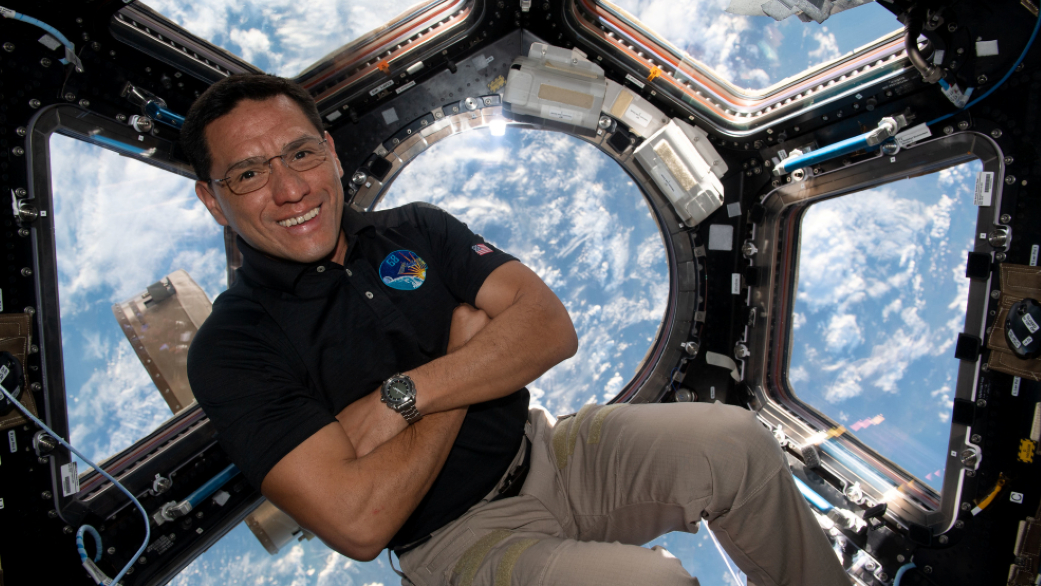NASA astronaut Frank Rubio surprised by his accidental record in space (video)
Frank Rubio was supposed to spend just 6 months in space, not a year.
If things had gone to plan, NASA astronaut Frank Rubio would've come home to Earth six months ago.
NASA's Frank Rubio and his two Russian Soyuz spacecraft crewmates on the International Space Station will finally wrap up their mission on Sept. 27 after a record-breaking year in space, should current schedules hold. Only a few other individuals have ever spent so long in orbit continuously before.
But their yearlong orbital stay came about by accident, as the spacecraft the trio was supposed to ride home suddenly sprang a leak in December 2022. Rubio did not directly address that incident, but he spoke about other challenges of a year in space on NASA Television's media channel Tuesday (Sept. 12), in a video recorded on Sept. 5.
"Maintaining that mental sharpness," was one of the most difficult things Rubio faced after a year in orbit, he said. "99.9% of the time that we're up here, it's just nominal ops. But trying to maintain that edge, to know that we can respond when we need to if something does go wrong, gets challenging the longer you stay up here. But like I've said, I've had great crew mates who've helped in that endeavor."
Related: Leaky Soyuz spacecraft at space station returns to Earth in speedy landing
The Soyuz MS-22 spacecraft launched to orbit on Sept. 21, 2022 carrying Rubio and Russian cosmonauts Sergey Prokopyev and Dmitri Petelin, for what was supposed to be a six-month mission. Halfway through their stay, on Dec. 14, the Soyuz rapidly lost all its coolant to space. Russian officials have said a micrometeoroid strike was likely to blame.
Russia's space agency Roscomos, consulting with NASA, discussed several options for bringing the crew home. Ultimately, the agencies decided to ship up a replacement Soyuz. The new spacecraft, however, would take some time to arrive in orbit.
Breaking space news, the latest updates on rocket launches, skywatching events and more!
As such, NASA created a temporary seat aboard a SpaceX Crew Dragon (already docked at the ISS) using tie-down straps, below the four spacecraft seats. In case of emergency, Rubio would evacuate with the rest of that four-person SpaceX crew, while the cosmonauts would go home on the crippled Soyuz. (The rationale was that with two people inside the Soyuz instead of three, the lack of coolant wouldn't be as big of a deal.)
That emergency scenario fortunately did not come to be. The replacement Soyuz (called MS-23) arrived safely on Feb. 25, removing the need for an unusual departure from the orbiting complex. But a relief crew could not arrive until yet another Soyuz spacecraft (MS-24) was ready, forcing Rubio and his colleagues to remain on board until the end of this month.
"My family has been the cornerstone that's inspired me to hopefully keep somewhat of a good attitude while I've been up here," Rubio said. "The resilience that my wife and kids showed — they faced a lot of challenges this past year — they just thrived throughout the whole entire process. Having that really made it so much easier to be up here, and I'm incredibly grateful for them."
Related: Russia's replacement Soyuz spacecraft arrives at space station
The MS-24 crew — NASA astronaut Loral O'Hara and Roscosmos cosmonauts Oleg Kononenko and Nikolai Chub — should launch toward the space station on Friday (Sept. 15). In the meantime, Rubio and his crew will join a group of super-elite people: including the trio, only seven people have ever spent more than a year in space continuously.
The longest single space mission was by Valery Polyakov, who banked 437 days in space aboard the then-Soviet Mir space station. Three other Soviet cosmonauts also surpassed 365 days on the same station: Sergey Avdeev, Musa Manarov and Vladimir Titov.
Rubio officially broke the U.S. record for continuous days in space on Sept. 11, logging 355 days. The only other American to reach that mark, NASA astronaut Mark Vande Hei, originally launched to space for a six-month mission in 2021, but he was warned pre-flight that his mission might be extended to a year due to space station staffing needs.
Vande Hei was at the other end of the conversation with Rubio in the video, and said the best part of his own long-duration stay was "the people that I got to spend that much time [with] … intensively, both working and playing as much as we possibly can. Opportunities present themselves. It was really a treat, that I got to share that time with wonderful people."
Rubio said he feels much the same way. "I have great crewmates, very special people, and they hold special places now because I've been able to share this experience with them."
Other long-duration NASA astronauts in space on a single mission include Scott Kelly (now retired) at 340 days, Christina Koch (now assigned to Artemis 2, a moon mission) at 328 days, Peggy Whitson (now with Houston's Axiom Space) at 289 days and Drew Morgan at 272 days.

Elizabeth Howell (she/her), Ph.D., was a staff writer in the spaceflight channel between 2022 and 2024 specializing in Canadian space news. She was contributing writer for Space.com for 10 years from 2012 to 2024. Elizabeth's reporting includes multiple exclusives with the White House, leading world coverage about a lost-and-found space tomato on the International Space Station, witnessing five human spaceflight launches on two continents, flying parabolic, working inside a spacesuit, and participating in a simulated Mars mission. Her latest book, "Why Am I Taller?" (ECW Press, 2022) is co-written with astronaut Dave Williams.

